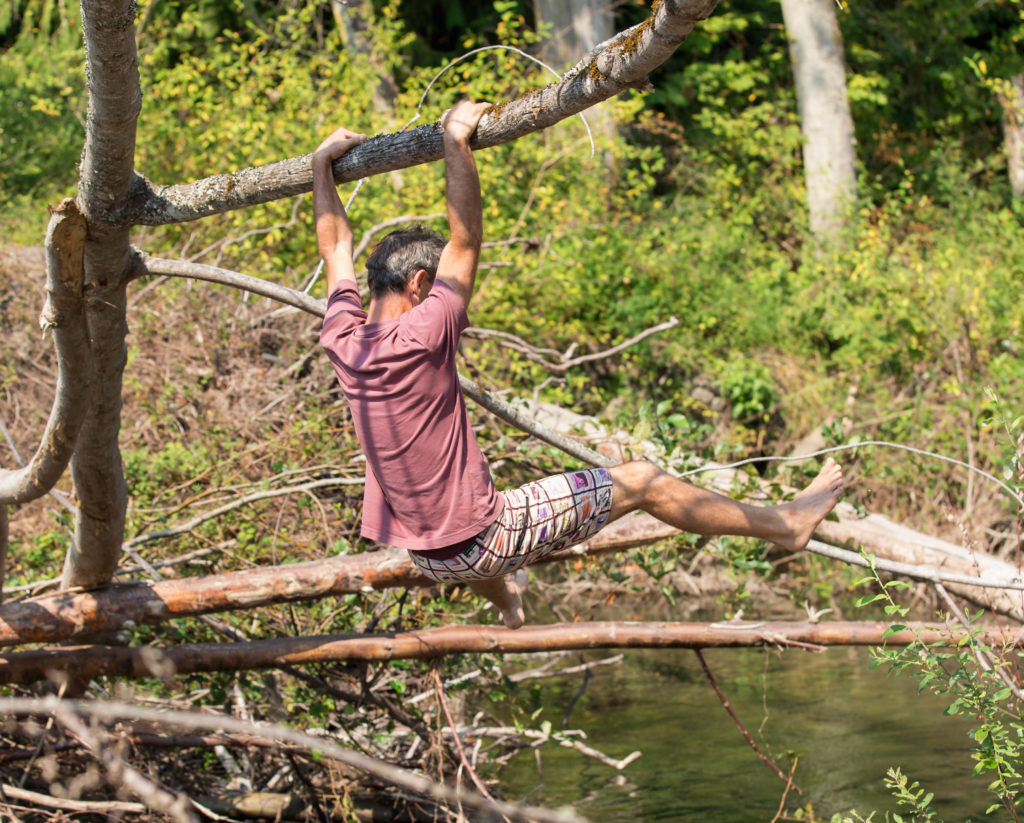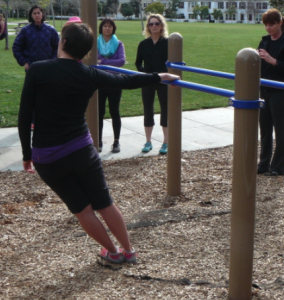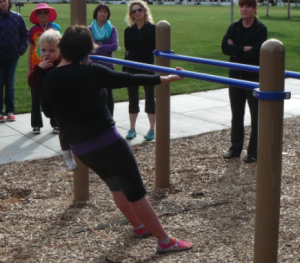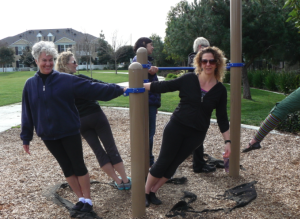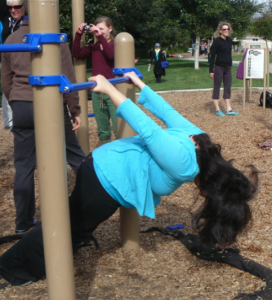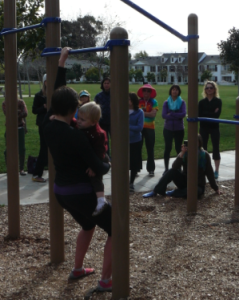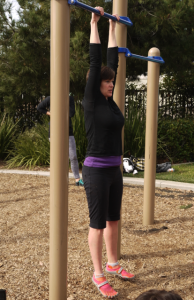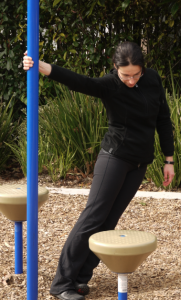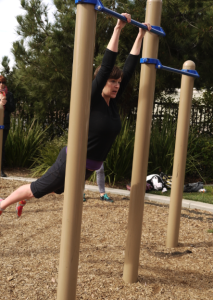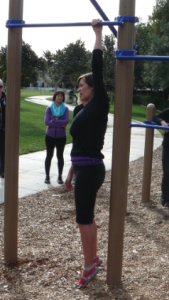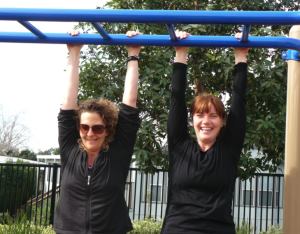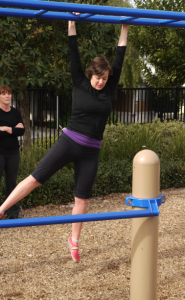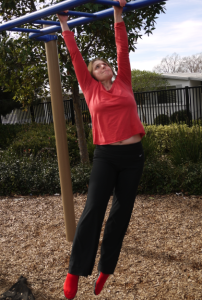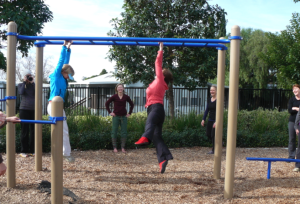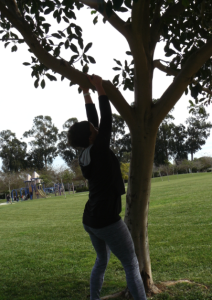I’ve written a handful (get it?) of posts on elements of hanging and swinging to support the Mouse Hands to Monkey Arms section of my book Move Your DNA. Recommended reading order is Hanging and Swinging 101, Hanging and Hand Skin, Upper Body Terrain, and Upper Body Texture. These posts have been updated November 2018 for easier use.
You’ve got parts of your body that can only be fully moved when you hang and swing. Just as each of your leg needs to be able to hold the rest of your body weight in order to walk well, the ability to hang and brachiate (hang from one arm and then the other) is the embodiment of a good strength to weight ratio of the upper body. Ideally this skill should have been developed as you were growing in height and mass; alas here we are maybe learning it for the first time.
To start it as an adult typically takes more than just doing it, especially if years of shoulder, neck and arm tension have created patterns of wear on your ligaments and left you with some major muscle atrophy.
This doesn't mean these natural movements are off the table; we just need to give some major TLC to our parts first. (You'll find preparatory moves in our Nutritious Movement Improvement course). In addition to prepping our parts with come corrective exercises, there are also transitional steps to loading hanging body parts.
If been 5 to 74 years since you’ve hung from something...
1. Start a hanging practice by leaning away from something. You can still use bars, but doorways are also great places to begin as you can get a lot more hanging just moving through your house or office.
2. Vary your grip (hold on in different ways) and hold a baby (or other weighted object) to increase the load.
3. Pay attention to your shoulder blades. Are they elevated? Can you do this gentle hang with out letting your scapula pop up towards your ears? Try both ways until you recognize the difference. And pay attention to your elbows. Are you able to stabilize them (hold them where you want) or are they uncontrollable? Make sure to practice these recommendations in Hypermobility (and 12 Steps to Stronger and More Stable Shoulders).
4. Now try all these with a bunch of friends. #vitamincommunitystyle
5. And try it backwards, and change the position of your feet for different loads.
6. Once you're ready to hang straight down from something, start with both feet on the ground. Use your legs as little or as much as you need to (and P.S. if you only have high bars as options, put a box or chair beneath them so you can still control the load with your feet.
7. Try it with your feet off the ground!
8. When you get tired, remember you don't have to stop your hanging training session, you can go always return to something more gentle, varying the shape and orientation of the bar. Remember that every movement you're doing has tremendous value.
9. Once you've adapted to hanging for longer and longer periods of time, you can start with a two-handed swing. This places a greater load on both your hands and arms, but your ability to tolerate it will come in handy when you moving one arm at a time.
10. Once you're swinging, check in with your shoulder blades again. It will take a little time, but eventually they should stay down on your back and not be rising up so much toward your ears. Keeping them down will help you use the larger muscles in the back and core to connect your upper body to your lover, vs. putting a tremendous load on the connective tissues. Said another way, in order for the movement to move more (and build more) muscle, you have to maintain a form that allows that to happen.
11. When you're ready to move on to swinging, you'll repeat everything above, only trying it one hand at a time, varying grip position, bar angles, etc.
12. Once you're ready to start moving down the monkey bars in the traditional sense (straight on) you can actually "shuffle" down their sides. You've seen people shuffle when you walk, yes? Shufflers keep both feet on the ground because they can't hold their body weight on one leg very well--they're lacking the strength or balance or probably both as they go hand in er, hand. You can use this "shuffle" is a great step to play with. It allows you to still share your weight between both hands, but you practice passing the weight from one arm to another, training them to carry a bit more than half your weight.
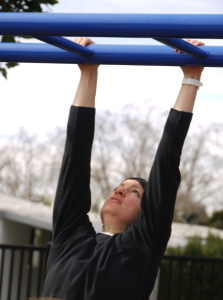
13. Then, you can shuffle with your friends (I'm all about moving with other people, can't you tell?).
14. Then, you can do with with slightly less shuffle and more swing, you just need to use your waist to move your hips from side to side, which actually takes weight off the hands a bit, making moving down the bar easier.
15. Repeat this "shuffle" a different way, with each hand holding the long parallel part of the bar (think palms facing each other).
16. Now you're ready to try taking to the monkey bars grade school style, hand over hand, taking one rung at a time. (This is such a triumphant picture and I love it.) These are the equivalent of small steps and you'll find that it's probably easier to always use the same side over and over again, always reaching for the next rung with the same hand. Try to take turns with your reaching arm.
17. Then try moving down the monkey bars two rungs at a time, meaning you never have two hands on the same rung. Walking the rungs this way is like taking a longer stride while walking. It requires more endurance than walking one rung at a time, and you'll need to be able to carry your body weight on both your right and left arms.
18. Then do all of the above with a friend or five.
Then, you can take to the trees, where the varying branch geometry changes with each tree and presents new loads for your skin and muscles to adapt to. Human movement has so many elements endless, so savor each step, and let your body catch up to your dreams. It will, eventually.
Don't have time to read this whole thing? Here's the cheat sheet to carrying your body with your upper body strength: Vary your hand positions and vary the surfaces you hang from. Vary the bars and sometimes head for the trees. The shape and texture of branches offer varied movement. So do different scapula and hand positions. The more you mix it up, the more of “you” you invite to the party, and a whole-body party is hella fun. That's right, I said "Hella."
